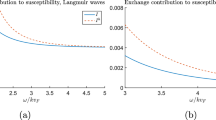Abstract
The model under consideration is the two-dimensional (2D) one-component plasma of point-like charged particles in a uniform neutralizing background, interacting through the logarithmic Coulomb interaction. Classical equilibrium statistical mechanics is studied by non-traditional means. The question of the potential integrability (exact solvability) of the plasma is investigated, first at arbitrary coupling constant Γ via an equivalent 2D Euclidean-field theory, and then at the specific values of Γ = 2*integer via an equivalent 1D fermionic model. The answer to the question in the title is that there is strong evidence for the model being not exactly solvable at arbitrary Γ but becoming exactly solvable at Γ = 2*integer. As a by-product of the developed formalism, the gauge invariance of the plasma is proven at the free-fermion point Γ = 2; the related mathematical peculiarity is the exact inversion of a class of infinite-dimensional matrices.
Similar content being viewed by others
REFERENCES
Ph. A. Martin,Rev. Mod. Phys. 60:1075 (1988)
L. Blum, C. Gruber, J. L. Lebowitz, and Ph. A. Martin,Phys. Rev. Lett. 48:1769 (1982).
B. Jancovici,J. Phys.: Condens. Matter 14:9121 (2002), and references quoted there.
A. Torres and G. Téllez,J. Phys. A 37:2121 (2004).
B. Jancovici, <nt>in</nt>Inhomogeneous Fluids, D. Henderson, <nt>ed.</nt> (Dekker, New York, 1992), pp. 201–237.
P. J. Forrester,Phys. Rep. 301:235 (1998).
A. Salzberg and S. Prager,J. Chem. Phys. 38:2587 (1963).
L. Šamaj,J. Phys. A 36:5913 (2003).
J. Ginibre,J. Math. Phys. 6:440 (1965).
R. E. Prange and S. M. Girvin,The Quantum Hall Effect (Springer, New York, 1987).
P. Di Francesco, M. Gaudin, C. Itzykson, and F. Lesage,Int. J. Mod. Phys. A 9:4257 (1994).
Ph. Choquard and J. Clérouin,Phys. Rev. Lett. 50:2086 (1983).
M. A. Moore and A. Pérez-Garrido,Phys. Rev. Lett. 82:4078 (1999).
B. Jancovici,Phys. Rev. Lett. 46:386 (1981).
P. Vieillefosse and J. P. Hansen,Phys. Rev. A 12:1106 (1975).
P. Kalinay, P. Markoš, L. Šamaj, and I. Travěnec,J. Stat. Phys. 98:639 (2000).
P. J. Forrester,J. Stat. Phys. 63:491 (1991).
B. Jancovici, G. Manificat,and C. Pisani,J. Stat. Phys. 76:307 (1994).
B. Jancovici and E. Trizac,Physica A 284:241 (2000).
G. V. Dunne,Int. J. Mod. Phys. B 7:4783 (1994).
T. Scharf, J. Y. Thibon, and B. G. Wybourne,J. Phys. A 27:4211 (1994).
L. Šamaj, J. K. Percus, and M. Kolesík,Phys. Rev. E 49:5623 (1994).
G. Téllez and P. J. Forrester,J. Stat. Phys. 97:489 (1999).
L. Šamaj and J. K. Percus,J. Stat. Phys. 80:811 (1995).
L. Šamaj, P. Kalinay, and I. Travěnec,J. Phys. A 31:4149 (1998).
S. Ghoshal and A. B. Zamolodchikov,Int. J. Mod. Phys. A 9:3841 (1994).
F. Cornu, B. Jancovici, and L. Blum,J. Stat. Phys. 50:1221 (1988).
I. S. Gradshteyn and I. M. Ryzhik,Tables of Integrals,Series, and Products, 5th edn. (Academic Press, London, 1994).
C. Deutsch and M. Lavaud,Phys. Rev. A 9:2598 (1974).
D. C. Brydges and Ph. A. Martin,J. Stat. Phys. 96:1163 (1999).
E. H. Lieb and H. Narnhofer,J. Stat. Phys. 12:291 (1975);<nt>ibid</nt>14:465 (1976).
R. Fantoni, B. Jancovici, and G. Téllez,J. Stat. Phys. 112:27 (2003).
P. Minnhagen,Rev. Mod. Phys. 59:1001 (1987).
N. V. Brilliantov,Contrib. Plasma Phys. 38:489 (1998).
J. Zinn-Justin,Quantum Field Theory and Critical Phenomena (Clarendon Press, Oxford, 1999), 3rd edn.
R. K. Dodd and R. K. Bullough,Proc. R. Soc. London A 352:481 (1977).
L. Šamaj,J. Stat. Phys. 111:261 (2003).
P. J. Forrester and B. Jancovici,Int. J. Mod. Phys. A 5:941 (1996).
B. Jancovici,J. Stat. Phys. 28:43 (1982).
F. A. Berezin,The method of Second Quantization (Academic Press, New York, 1966).
M. L. Mehta,Random Matrices, 2nd edn. (Academic, London, 1990).
L. D. Landau and E. M. Lifshitz,Electrodynamics of Continuous Media, 2nd edn. (Pergamon, Oxford,1963), Chapter I.
Ph. Choquard, B. Piller, R. Rentsch, and P. Vieillefosse,J. Stat. Phys. 55:1185 (1989).
B. Jancovici and L. Šamaj,J. Stat. Phys. 114:1211 (2004).
Author information
Authors and Affiliations
Rights and permissions
About this article
Cite this article
Šamaj, L. Is the Two-Dimensional One-Component Plasma Exactly Solvable?. Journal of Statistical Physics 117, 131–158 (2004). https://doi.org/10.1023/B:JOSS.0000044056.19438.2c
Issue Date:
DOI: https://doi.org/10.1023/B:JOSS.0000044056.19438.2c



